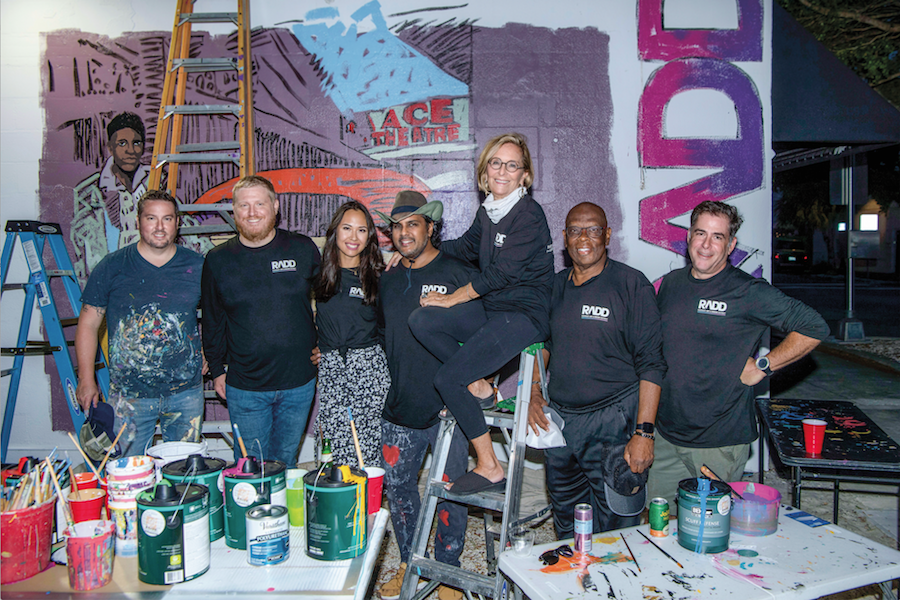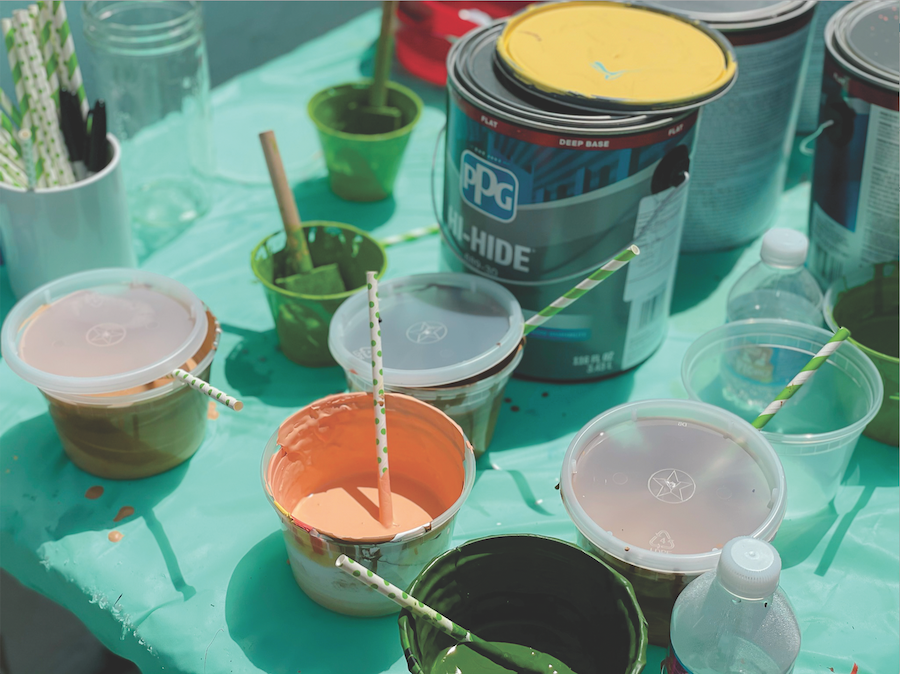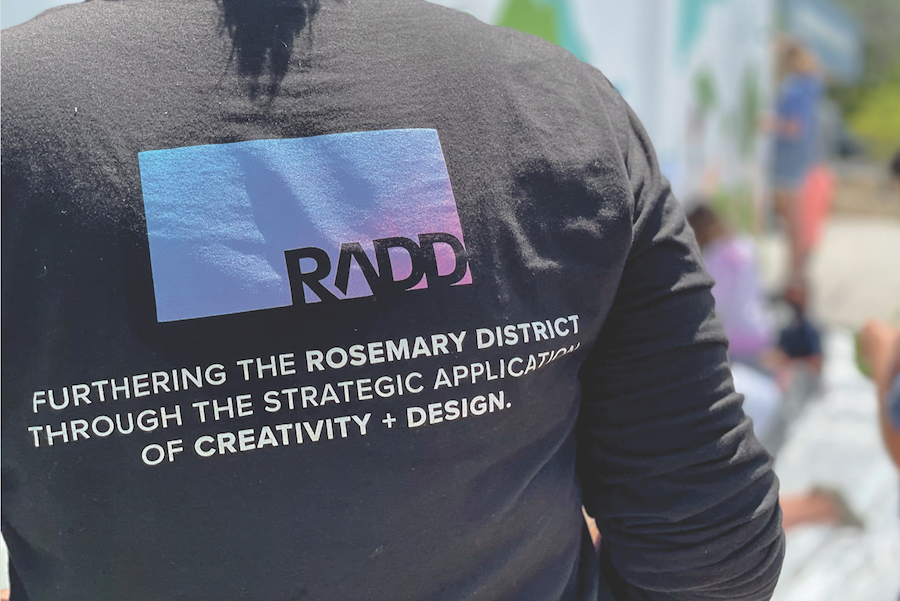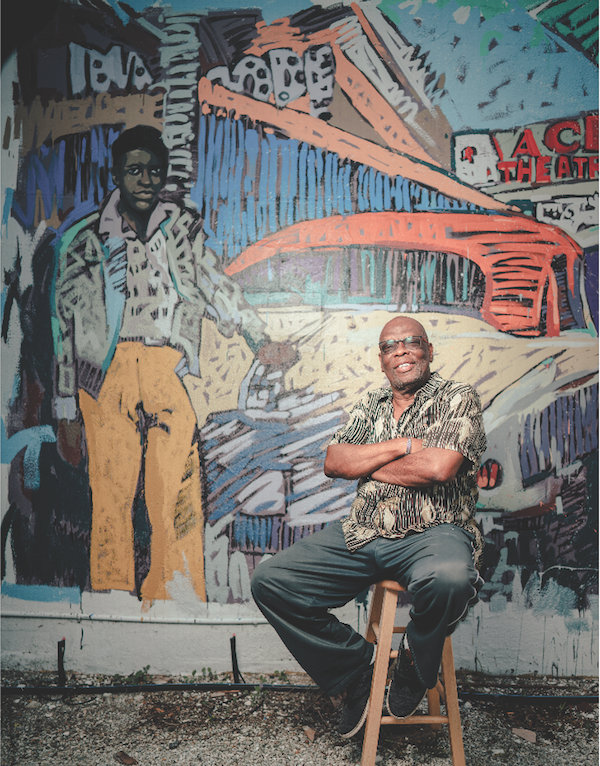It started with a series of cold calls. Walter Gilbert was in search of blank walls in the Rosemary District and he was in a bit of a hurry. The fourth-generation Sarasota native was in a race against the rapidly developing neighborhood to preserve some of said history. And, as a self-proclaimed history buff with an encyclopedic knowledge of Sarasota’s Black history, he was well-positioned to pass down the stories he heard and lived. “I was born in ‘52 and was involved in a lot of big changes,” he says, “beach boycotts, desegregation, election law changes; but since 1917, that history—my history—has slowly been obliviated.”

THE TEAM STANDS RADD AND PROUD IN FRONT OF ITS FIRST MURAL, PAINTED BY TIM JAEGER AT 600 CENTRAL AVE. IN THE ROSEMARY DISTRICT
Armed with gripping stories of perseverance and excellence, Gilbert sought to secure the support of some property and business owners in what was once called Overtown, hoping to use some of their blank walls for murals to memorialize the neighborhood’s original Black settlers. “I just felt like the city’s Black history wasn’t being counted, recorded and known,” says Gilbert, “so I thought what better way to honor the history in a loud and meaningful way than with murals?” Some owners were more receptive than others, none more than Anand Pallegar. “I got a call from a guy who I’d never met before, asking if I’d be interested in putting some murals on a building I owned downtown,” says Pallegar, “and it didn’t take long to realize there was a big opportunity here.” Pallegar is a serial entrepreneur whose portfolio of businesses includes DreamLarge, an events and marketing outfit that focuses on nonprofit and community improvement work. Equally important, Pallegar owns the building at 513 Central Avenue, formerly the site of the Payne Chapel African Methodist Episcopal Church built in 1908—a building Pallegar restored into an office suite.

IMAGE COURTESY OF DREAMLARGE
According to Gilbert, it’s one of the few remaining original buildings of Overtown, which meant the first walls he secured were arguably some of the most important. But bigger than the acquisition of these prized walls, Gilbert enlisted a champion of the cause who, coincidentally, had been brainstorming for years about ways to give Rosemary District its own identity.

IMAGE COURTESY OF DREAMLARGE
“Anand was looking for ways to turn the Rosemary District into an art and design destination,” says Gilbert, “and he understood how this could give the neighborhood an identity and a purpose.” Rosemary Art and Design District (RADD) is that identity and purpose. The acronym for RADD—possibly the most fortuitous acronym in human history—was devised a few years ago by a group of Rosemary District community activists, including Pallegar and Susan McLeod, a real estate agent with a background in the arts who was eager to raise the profile of the neighborhood’s creative vibes. Along with painter, curator and current RADD member, Tim Jaeger, conversations were had about how to bring more visual art to the area. “That first go around didn’t work out,” says McLeod, “but once Walter spoke with Anand, we felt like we had our mission now. So RADD was just a really organic thing.”
With Gilbert’s mural idea reanimating the group into action, RADD settled on a flagship goal, the roots from which the whole endeavor could branch: The Gilbert Mural Initiative, a multi-year campaign to commission murals in the Rosemary District that will celebrate its Black history. And within RADD’s branches are festivals, art walks, markets, seminars and all manner of mind-expanding, soul-enriching programming centered on inclusivity, diversity, creativity and, of course, art. “It started out with the mural initiative, but we’ve really expanded the focus to cultivate creativity,” says Julia Groom, director of DreamLarge and one of RADD’s founding members. On any given day, Groom might help a client with a marketing strategy, plan a symposium from scratch or apply paint to a wall alongside a group of kids creating a mural. She brings that same anything-goes mentality to RADD when deciding on what’s next.“Five to 10 years down the road, we think we can elevate this neighborhood for everyone that lives around here,” says Groom, “and when you build it on the history, it has an opportunity to connect people.”Gilbert shares a similarly rosey outlook for the future that RADD can help create. “In the end, we want to educate people about Sarasota’s Black history,” says Gilbert, “we want to bring people together, and we’re gonna do it with art.”









